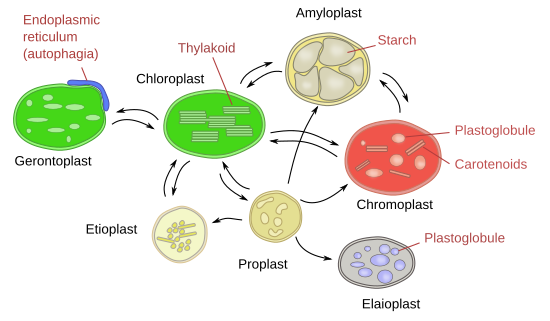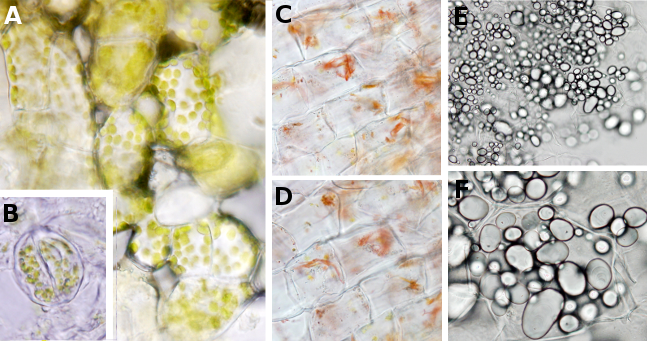Plastids are organelles found in plant and algal cells, although they are also found in some marine animals. These organelles arose during evolution after an endosymbiosis process, when a bacterium with photosynthetic abilities, similar to current cyanobacteria, was engulfed by a eukaryote cell and became an endosymbiont instead of being digested. During evolution, most genes of the engulfed cyanobacteria were transferred to the host nucleus, and endosymbiont became plastids, a fundamental type of organelle in the cell. Plastids developed a diverse set of functions: photosynthesis, amino acid and lipid synthesis, storage of lipids, carbohydrates and proteins, providing color to different parts of the body plant, sensing gravity, regulation of stomata behavior, and many others.
Plastids are limited by two membranes separated by an intermembrane space. Inside, they contain other membrane-bond compartments like the thylakoids of chloroplasts and tubules of chromoplasts. Plastids also contain circular DNAmolecules and the molecular machinery to grow and divide, both processes are under the control of the nuclear genes.
Plastids always come from another existing plastid, and they are transmitted to the next plant generation within the gametes during fertilization. In this way, all plastids in a plant are descendants of the embryonic plastids, known as proplastids. Proplastids are also found in meristematic cells of adult plants, where they divide before the cell division to ensure a proper number of proplastids in the two new cells. When cell differentiation begins, proplastids also initiate their own differentiation program, so that different types of mature plastids are generated according to the cell type. They can be leucoplasts (elaioplasts, amiloplasts, and proteoplasts), chloroplasts and chromoplasts. Chloroplasts may also differentiate into other types of plastids, and other plastids may differentiate into chloroplasts. It is a bidirectional differentiation path (Figure 1).

1. Proplastids
Proplastids are small plastids, about 1 µm in diameter, and less complex at the structural level than other plastids of the plant. They are colorless, can change their morphology, and may contain a variable amount of tubular-like internal membranous compartments and starch depots. These features are actually shared by two types of proplastids: germinal and nodule proplastids. Germinal proplastids are found in plant embryos (seeds) and meristematic cells. Proplastids can be transmitted by the egg (in angiosperms) or by the pollen grain (in conifers). Anayway, all the plastids of a plant come from only one progenitor, so all of them share the same genome. Through proliferaton and differentiation, the role of proplastids is to give rise to all the plastids of the plant. Proplastids may also carry out some metabolic functions, such as gibberellic acid synthesis, which is very important for meristematic metabolism. Nodule proplastids, as the name suggests, are found in the nodules of the roots and are involved in the fixation of nitrogen. Proplastids differentiate into chloroplasts at the apex of stems and branches, and in the embryo during germination.
Etioplasts, another type of plastid, are found in stems but not in roots. They are a long-lasting intermediate stage in the way of differentiation from proplastids to chloroplasts under very low intensities of light or darkness. Etioplasts resume their differentiation into chloroplasts as soon as the light is intense enough.
Etioplasts develop reticular paracrystalline structures called pro-lamellar bodies. Prothylacoidal laminar, which contain membranes with chlorophyll precursors, are structures that irradiate from pro-lamellar bodies . When exposed to light, the pro-lamellar bodies are transformed into thylakoids. Galactolipids are the main component of thylakoid membranes, and they are essential for a functional thylakoidal membrane. For instance, galactolipids are needed for the correct insertion in the thilakoidal membranes of proteins involved in photosynthesis, such as photosystems and cytochromes. Light activates the enzymes that transform proto-chlorophyll into functional chlorophyll.
2. Leucoplasts
Leucoplasts are colorless plastids (without pigments) that function as storing organelles. Leucoplasts comprise amyloplasts, elaioplasts (or oleoplasts), and proteinoplasts. They store starch, lipids and proteins, respectively. Their average size is smaller than the chloroplasts of leaves. Leucoplasts have been found in the epidermis, parenchyma, root tissues, meristems and reproductive tissues.
In plant cells, amyloplasts synthesize starch (Figure 2). They are abundant in the stem and root parenchyma, tubercles, and some seeds. The starch synthesis in plants is restricted to plastids, so all the stored starch in a cell is found in plastids as starch granules. Amyloplasts are specialized in this role and contain large depots of starch. Some amyloplasts are called simple because they contain only one starch depot, while complex amyloplast show several starch depots. Apart from storing starch, amyloplasts are gravity sensors in root cells. Starch granules are denser than water, so amyloplasts fall to the bottom of the cell, and this is what cells need to detect the gravity vector because the contact site of the amyloplast with the cell membrane is bottom and it determines the root curvature. These amyloplasts involved in gravity sensing are known as statolisths. Amyloplasts are also involved in the metabolism of nitrogen.
Elaioplasts are small plastids containing oil and lipids, forming fat drops. They are abundant in seeds and cotyledons. In plant cells, there are two synthetic pathways for lipids. The eukaryotic pathway depends on the smooth endoplasmic reticulum, whereas the so-called prokaryotic pathway involves elaioplastids. These two pathways yield different types of lipids. Some plants are able to store lipids in other organelles known as elaiosomes, which are derived from endoplasmic reticulum. Elaioplast are also involved in pollen maturation.
Proteinoplasts contain a high concentration of proteins, so high that proteins form crystals or very dense amorphous material. However, it is not clear yet if there is a type of plastid exclusively dedicated to protein storage in plant cells. Proteins storage is highly developed in seeds
There are sensory plastids involved in the interaction of the plant with the environment. They are small organelles with the ability to send small membranous expansions known as stromules. The length and number of stromules depend on environmental variables. For instance, they are observed in roots during the interaction with fungi.
3. Chromoplasts
Chromoplasts contain carotenoid pigments that give the red, orange and yellow colors to the plant structure where they are present (Figure 2) and lack chlorophyll. These plastids are abundant in flowers, fruits, old leaves, and some roots. One of their main functions is to attract animals for pollination or to spread the seeds. Chromoplasts are metabolically active, though they contain fewer DNA copies than chloroplasts. They are derived from chloroplasts and proplastids. During differentiation from chloroplasts, the thylakoidal photosynthetic sytems are degraded. Carotenoids are stored in chromoplasts in different ways. Thus, globular chromoplasts keep carotenoids in compartments known as plastoglobules, which are lipoprotein particles linked to the inner membrane through a lipid monolayer, and they store lipids. These are the most common chromoplasts. The membranous chromoplasts store carotenoids in concentrically arranged membranes. The tubular chromoplasts place carotenoids in filliform structures. Finally, crystalline chromoplasts show carotenoids highly packaged in crystal form.

Chromoplasts develop an internal, layered membrane system in the outer part of the stroma. These new membranes arise from the invagination of the inner membrane and not from the old degraded thylakoids. Carotenoids like lutein, beta-carotenoid, and others, may also be associated with these new membranes. Occasionally, the internal membranes show a reticular arrangement.
Although chromoplasts have been considered an advanced stage of the chloroplast development, it has been observed that they are able to become chloroplasts again. For instance, some root and fruit tissues may become green again. For example, lemon fruits that are left on the tree change the color from yellow to green, and carrot roots turn green when they are exposed to the light.
4. Chloroplasts
Chloroplasts are the most abundant and studied plastids. They will be study in the next page.
5. Another types of plastids
During aging and death periods, plant cells contain gerontoplasts, which are differentiated from chloropasts. Gerontoplasts are labeled for degradation, lack starch granules, show degraded thylakoids and chlorophyll, and contain large and numerous platoglobules. Phenyloplasts store phenolic components that show color. They are not classified as chromoplasts, though, because of their inner organization and the homeostatic nature of phenols. Xyloplasts are plastids of the secondary vascular system specialized in the synthesis of monoligol. Muroplasts are found in glaucocystophyta algae and contain a vestigial wall of peptidoglycan located between inner and outer membranes of the organelle. Type S and T plastids have been found in the sieve cells of the phloem and may respond to wounds. Rhodoplasts are photosynthetic plastids found in red algae and contain type a chlorophyll but not b or c chlorophyll. Rhodoplasts contain thylakoids not arranged in stacks and also molecular aggregates containing red pigments known as phycobilisomes, which are able to capture the light wavelengths that reach long distances under the seawater. Finally, some animals eat algae, and chloroplasts are incorporated into the animal cells instead of being digested. These plastids are able to photosynthesize for months, feeding in this way the animal (for example, Elysia chlorotica). These plastids are known as cleptoplasts. Furthermore, some parasites, like Plasmodium, may contain plastids known as apicoplasts.
-
Bibliography ↷
-
Bibliography
Choi H, Yi T, Ha S-H. 2021. Frontiers in plant science. Diversity of plastid types and their interconversion. 12: 692024. doi: 10.3389/fpls.2021.692024.
Jarvis P, López-Juez E. 2013. Biogenesis and homeostasis of chloroplasts and other plastids. Nature reviews in molecular and cell biology. 14: 787-802.
Ljubesic N, Wrischer M, Devidé Z. 1991. Chromoplasts--the last stages in plastid development. International journal of development biology. 35: 251-258.
Wise RR. 2006. The diversity of plastid form and function. In The structure and function of plastids. Springer Netherlands. p. 3-26.
-
 Mitochondria
Mitochondria